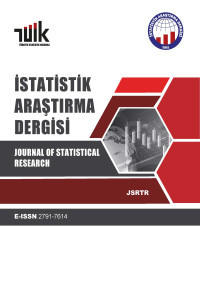Türkiye Nüfus ve Sağlık Araştırması 2008 Verisi Üzerinde Bir CoPlot Uygulaması
Çok boyutlu ölçeklemenin bir uzantısı olan CoPlot yöntemi, gözlemler arasındaki ve değişkenler arasındaki ilişkileri aynı grafik üzerinde inceleme fırsatı verir. CoPlot, birbiri üzerine çizdirilen iki grafikten oluşur. İlk grafik n sayıda çok değişkenli gözlemin iki boyutlu uzaydaki dağılımını gösterir. İkinci grafik her biri bir değişkeni temsil eden p sayıda oktan oluşur. CoPlot sayesinde araştırmacılar tek bir grafik ile çok değişkenli veri kümesi hakkında daha detaylı yorumlar yapabilirler. CoPlot kolay anlaşılabilir olduğu için sosyo-ekonomi, ekonomi, tıp gibi çeşitli disiplinlerde kullanılmıştır, ancak demografik çalışmalarda kullanılmamıştır. Bu çalışmada, CoPlot kısaca açıklanacak ve “Türkiye Demografik ve Sağlık Anketi 2008” veri kümesinin bir parçası üzerinde basit bir uygulaması sunulacaktır. CoPlot yönteminin çok değişkenli veri kümesini görsel olarak yorumlama üstünlüğü bu özgün veri kümesi ile vurgulanacaktır.
Anahtar Kelimeler:
Kruskal raw stress, Çok boyutlu ölçekleme, Scree plot
An Application of CoPlot on Turkey Demographic and Health Survey 2008 Data
CoPlot method, an extension of multidimensional scaling, gives opportunity to investigate the relations between the observations, and between the variables on the same map. CoPlot consists of two graphs drawn on each other. First graph represents the distribution of n multivariate observations in a two dimensional space. The second graph consists of p arrows each representing a variable. By means of CoPlot, researchers can make more detailed comments about the multivariate data set with a single map. Since CoPlot is easy to understand, it has been used in various disciplines such as socioeconomic, economics and medicine but not in the demographic studies. In this study, CoPlot is briefly explained and a simple application of the method on a part of "Turkey Demographic and Health Survey, 2008" data set is presented. Superiority of CoPlot about visually interpreting the multivariate data set is emphasized by using an exceptional data set.
Keywords:
Kruskal raw stress, Multidimensional scaling, Scree plot,
___
- Borg, I., Groenen, P. J. F., 2005. Modern Multidimensional Scaling, 2nd edition, Springer.
- Bravata, D. M., Shojania, K. G., Olkin, I., Raveh, A., 2008. CoPlot: A Tool for Visualizing Multivariate Data in Medicine, Statistics in Medicine, 27, 2234-2247.
- De Leeuw, J., 1977. Application of Convex Analysis to Multidimensional Scaling, In: J. Barra et al. Recent Developments in Statistics, 133-145.
- Hastie, T., Tibshirani, R., Friedman, J., 2008. The Elements of Statistical Learning, 2nd edition.
- Huang, H., Liao, W., 2012. A CoPlot-based Efficiency Measurement to Commercial Banks, Journal of Software 7:10, 2247-2251.
- Kruskal, J. B., 1964a. Nonmetric Multidimensional Scaling: A Numerical Method, Psychometrika, 29:2, 115-129.
- Kruskal, J. B., 1964b. Multidimensional Scaling by Optimizing Goodness of Fit to A Nonmetric Hypothesis, Psychometrika, 29:1, 1-27.
- Lipshitz, G., Raveh, A., 1998. Socio-economic Differences Among Localities: A New Method of Multivariate Analysis, Regional Studies, 32:8, 747-757.
- Raveh, A., 2000. CoPlot: A Graphic Display Method for Geometrical Representations of MCDM, European Journal of Operational Research, 125, 670-678.
- Talby, D., Feitelson, D. G., Raveh, A., 1999. Comparing Logs and Models of Parallel Workloads Using the CoPlot Method, Lecture Notes in Computer Science 1659, 43-66.
- Weber, Y., Shenkar, O., Raveh, A., 1996. National and Corporate Cultural Fit in Mergers/Acquisitions: An Exploratory Study, Management Science 42:8, 1215-1227.
- ISSN: 1303-6319
- Başlangıç: 2002
- Yayıncı: TÜİK
